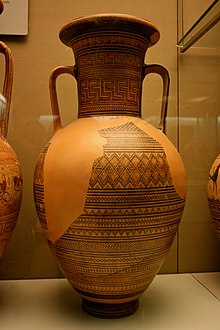Elgin Amphora
Appearance

The Elgin Amphora is a large
Geometric style, and attributed to an unknown artist given the Notname of "the Dipylon Master", one of the earliest individually identifiable Greek artists. The fragments have been restored to reconstruct a single but incomplete vessel, 67 centimetres (26 in) high, which is now displayed at the British Museum
in London.
The amphora stands on a rim foot. The outer surface of its ovoid body is decorated with bands of geometric patterns, including repeated lozenges in a tapestry design around the widest part of the amphora, rows of triangles, and a chequered pattern on its shoulders. The tall cylindrical neck bears a double meander, and a frieze of water birds just below the rim. The strap handles are decorated with dotted serpents.
Fragments of the amphora were excavated in Athens by
The Art Fund, and funds from the Wolfson Foundation, Alexander Talbot Rice, British Museum Friends, the Caryatid Fund, and the Society of Dilettanti
Charitable Trust
References
- The Elgin Amphora, British Museum
- Elgin Amphora by Dipylon Workshop, Athens, Art Fund
- Elgin Amphora[dead link], Google Arts & Culture
